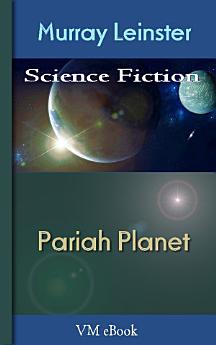Pariah Planet: Leinster'S Science Fiction
اس ای بک کے بارے میں
There was a certain coldness in the manner of those at the Weald spaceport when the Med Ship left next morning. Calhoun was not popular because Weald was scared. It had been conditioned to scare easily, where blueskins might be involved. Its children were trained to react explosively when the word "blueskin" was uttered in their hearing, and its adults tended to say "blueskin" when anything to cause uneasiness entered their minds. So a planet-wide habit of non-rational response had formed and was not seen to be irrational because almost everybody had it.
The volunteer who'd discovered the tragedy on the ship from Orede was safe, though. He'd made a completely conscientious survey of the ship he'd volunteered to enter and examine. For his courage, he'd have been doomed but for Calhoun. The reaction of his fellow-citizens was that by entering the ship he might have become contaminated by blueskin infective material if the plague still existed, and if the men in the ship had caught it—but they certainly hadn't died of it—and if there had been blueskins on Orede to communicate it—for which there was no evidence—and if blueskins were responsible for the tragedy. Which was at the moment pure supposition. But Weald feared he might bring death back to Weald if he were allowed to return....
درجہ بندی اور جائزے
مصنف کے بارے میں
Murray Leinster (June 16, 1896 – June 8, 1975) was a nom de plume of William Fitzgerald Jenkins, an award-winning American writer of science fiction and alternate history. He wrote and published more than 1,500 short stories and articles, 14 movie scripts, and hundreds of radio scripts and television plays.
Leinster was born in Norfolk, Virginia, the son of George B. Jenkins and Mary L. Jenkins. His father was an accountant. Although both parents were born in Virginia, the family lived in Manhattan in 1910, according to the 1910 Federal Census.
He began his career as a freelance writer before World War I; he was two months short of his 20th birthday when his first story, "The Foreigner", appeared in the May 1916 issue of H. L. Mencken's literary magazine The Smart Set. Over the next three years, Leinster published ten more stories in the magazine. During and after World War I, he began appearing in pulp magazines like Argosy, Snappy Stories, and Breezy Stories. He continued to appear regularly in Argosy into the 1950s. When the pulp magazines began to diversify into particular genres in the 1920s, Leinster followed suit, selling jungle stories to Danger Trails, westerns to West and Cowboy Stories, detective stories to Black Mask and Mystery Stories, horror stories to Weird Tales, and even romance stories to Love Story Magazine under the pen name Louisa Carter Lee.
Leinster's first science fiction story, "The Runaway Skyscraper", appeared in the February 22, 1919 issue of Argosy, and was reprinted in the June 1926 issue of Hugo Gernsback's first science fiction magazine, Amazing Stories. In the 1930s, he published several science fiction stories and serials in Amazing and Astounding Stories (the first issue of Astounding included his story "Tanks"). He continued to appear frequently in other genre pulps such as Detective Fiction Weekly and Smashing Western, as well as Collier's Weekly beginning in 1936 and Esquire starting in 1939.
Leinster is credited with the invention of parallel universe stories. Four years before Jack Williamson's The Legion of Time came out, Leinster published his "Sidewise in Time" in the June 1934 issue of Astounding. Leinster's vision of extraordinary oscillations in time ('sidewise in time') had a long-term impact on other authors, for example Isaac Asimov's "Living Space", "The Red Queen's Race", and The End of Eternity.









